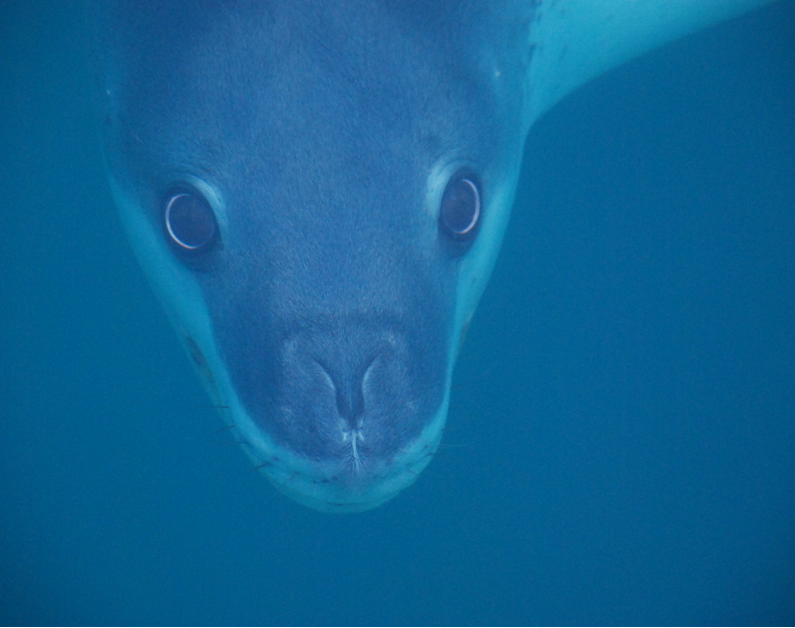A comparison of the structure of leopard seal songs to those of other mammals and various forms of human music has found the closest counterpart to be nursery rhymes. Unsurprisingly, however, the evolutionary driver for this repetitiveness is not the same as why we teach these songs to our children.
Food is scarce in the waters off Antarctica, so apex predators need large territories to sustain themselves. That’s a problem come mating season, because even finding potential partners can be a challenge, let alone convincing them to intermingle genes. Male leopard seals (Hydrurga leptonyx) address this challenge by singing for hours each day from late October to early January in the hope a female will hear and be impressed.
The songs are not continuous, since after two minutes of vocalization the seals surface for two minutes to breathe, but they are consistent. For months at a time, a male seal will sing for around 400 cycles over a 13-hour day.
“They’re like the songbirds of the Southern Ocean. During the breeding season, if you drop a hydrophone into the water anywhere in the region, you’ll hear them singing,” said Professor Tracey Rogers of the University of New South Wales in a statement.
Rogers started collecting leopard seal recordings for her PhD in the 1990s and had current student Lucinda Chambers look for patterns in the songs, taking advantage of analytical techniques not available when the collections began.
“When we compared their songs to other studies of vocal animals and of human music, we found their information entropy – a measure of how predictable or random a sequence is – was remarkably close to our own nursery rhymes,” Chambers said.
She told IFLScience that the nursery rhymes the songs were compared with were taken from The Golden Song Book, published in the 1950s, with familiar classics such as Baa Baa Black Sheep and Three Blind Mice. Meanwhile, the progression of notes in other human music, including the work of classical Baroque and Romantic composers and the Beatles, is far more complex.
All leopard seal songs, at least from East Antarctica where the collections were made, consist of the same five features, which the pair refer to as notes. “You can’t tell them apart by how the call sounds,” Rogers said, although perhaps there is something there only other leopard seals can recognize that sounds suitably sexy or scary.
Where some other species win respect with the originality of their range, leopard seals make repetition work for them. “They’ve stylised it to an almost boring degree, which we think is a deliberate strategy, so their call carries a long distance across the ice,” Rogers said. An album of leopard seal songs probably wouldn’t compete among a human audience with those of whales, and Rogers and Chambers certainly won’t become the new Rogers and Hammerstein by turning their subjects’ voices into musicals.

They’re not the most flexible vocalists you’ll meet, but what they lack in originality they make up for in perseverance.
Image Credit: Professor Tracey Rogers
Humpback whales have a variety of ways to encode information in their songs, including the timing, ordering, and overlapping of songs. Leopard seals instead seem to rely on the ordering alone, which is less likely to be lost over a distance, but therefore must be repeated endlessly.
Unlike whale songs, there also appears to be little sign of the songs undergoing fashions. “If we compare the recordings from the 1990s to those made today, some are the same,” Chambers told IFLScience, although the pair and co-author Dr John Buck of the University of Massachusetts Dartmouth plan to investigate this further, to see if new calls have emerged. Chambers said there may also be regional variations in places they have not sampled.
Clearly the approach. “It’s incredibly energetically demanding,” Chambers told IFLScience. Whether or not they stop hunting entirely to sing, Chambers thinks it likely that the male seals stock up on food before mating season so they can run their reserves down while singing.
Female seals also sing, although much more intermittently and all year round. Chambers told IFLScience the reason is unknown. “They could be communicating with their pups, perhaps teaching their pups the sounds, since we don’t know how seals learn them. It could also be a marker of territory.”
Nursery rhymes don’t have the same need to travel a long distance. Instead, it is thought humans use the simplicity because that is what the infant brain’s memory can handle. How the brain of a leopard seal compares to that of a child is a question for a neuroscientist, Chambers told IFLScience, but she added, “they have a similar capacity to remember a melody.”
The study is open access in Scientific Reports.
Source Link: Beneath Antarctica’s Sea Ice, Leopard Seals Sing Nursery Rhymes In Search Of Love